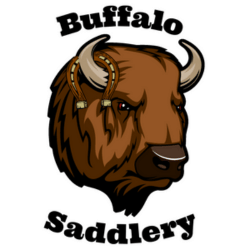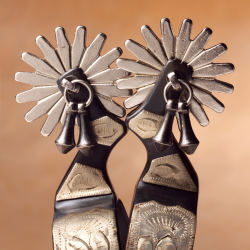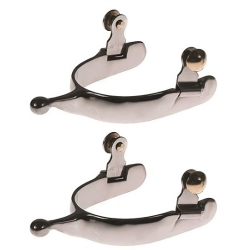Horses are magnificent creatures that have been a loyal companion to humans for centuries. Whether used for work, recreation, or competitive sports, it is important to ensure their safety and comfort during any activity. One essential piece of equipment that plays a crucial role in horse tack is the breast collar.
In this blog post, we will delve into the world of fringe breast collars and explore their significance in the equestrian community. We will discuss why a fringe breast collar is a popular choice among horse owners, how to choose the right one, and provide valuable insights on how to properly use and maintain this unique piece of equipment.
A fringe breast collar is not just a stylish accessory; it serves a vital purpose in keeping the saddle in place and preventing it from sliding back during riding. It effectively distributes the weight of the saddle across the horse's chest, providing stability and balance. Additionally, a fringe breast collar can add a touch of flair to your horse's appearance, making them stand out in the show ring or on the trails.
When selecting a fringe breast collar, several factors should be considered. The material and durability of the collar are crucial to ensure that it can withstand the rigors of regular use. Taking accurate measurements of your horse's chest is also essential to ensure a proper fit. Furthermore, choosing the right style and color can not only enhance your horse's aesthetic but also reflect your personal taste.
Once you have chosen the perfect fringe breast collar, it is important to know how to use and adjust it correctly. Properly fitting the collar on your horse is crucial to ensure their comfort and safety. Making necessary adjustments and regularly checking for signs of discomfort are vital to prevent any potential issues.
In order to prolong the lifespan of your fringe breast collar, proper maintenance is necessary. Regular cleaning and care will keep it in good condition and ensure its longevity. Knowing when to replace your collar is also important to ensure the safety of your horse. Finally, we will provide tips on how to store your fringe breast collar properly when not in use.
By the end of this blog post, you will have a comprehensive understanding of fringe breast collars, their importance, and how to effectively use and maintain them. So, let's dive in and discover the world of fringe breast collars for horses!
Introduction to Fringe Breast Collars
Fringe breast collars are a unique and eye-catching variation of the traditional breast collar. They are designed with decorative fringes that hang down from the collar, adding a touch of elegance and style to your horse's attire. In this section, we will explore the origins of fringe breast collars, their evolution, and the different styles available in the market today.
Origins of Fringe Breast Collars
The use of breast collars dates back centuries, with their origins traced to the need for stability and control while riding horses. As horsemanship evolved, so did the design and functionality of breast collars. Fringe breast collars, however, emerged as a distinctive style in more recent times.
The origins of fringe breast collars can be attributed to the Native American culture, where fringes were commonly used in their traditional attire, including horse tack. Fringes were not only aesthetically pleasing but also served a practical purpose of deterring insects and providing protection against the elements.
Evolution of Fringe Breast Collars
Over the years, fringe breast collars have gained popularity beyond their cultural origins. Equestrians worldwide have embraced this unique style, recognizing its ability to enhance the overall appearance of both horse and rider. Fringe breast collars have become a fashion statement in various equestrian disciplines, including western pleasure, trail riding, and even in some English riding disciplines.
The design of fringe breast collars has evolved to cater to different tastes and preferences. While the fringes were initially made of natural materials such as leather or horsehair, modern options now include synthetic materials that offer a wide range of colors, lengths, and textures. This allows riders to customize their fringe breast collars to match their individual style.
Styles of Fringe Breast Collars
Fringe breast collars come in various styles to suit different disciplines and personal preferences. Some collars feature long, flowing fringes that create a dramatic effect, while others have shorter fringes for a more subtle look. The fringes can be uniform in length or graduated, adding depth and dimension to the collar.
In addition to the length and style of the fringes, fringe breast collars also come in different collar designs. Some collars have a straight, wide shape, while others may feature a contoured or scalloped design to better fit the horse's chest. The choice of collar design depends on factors such as the horse's conformation and the rider's aesthetic preferences.
Whether you are looking for a classic and timeless look or a bold and modern statement, there is a fringe breast collar style that will suit your taste and complement your horse's appearance.
In the next section, we will explore the reasons why equestrians choose to use fringe breast collars and the important role they play in ensuring the comfort and safety of both horse and rider.
Why Use a Fringe Breast Collar
Fringe breast collars have become increasingly popular among horse owners and riders for various reasons. In this section, we will explore the important role that a fringe breast collar plays in enhancing the riding experience and ensuring the comfort and safety of both horse and rider.
The Important Role of a Breast Collar
Before delving into the specific benefits of a fringe breast collar, it is important to understand the primary function of a breast collar itself. A breast collar is a piece of horse tack that is designed to prevent the saddle from sliding back on the horse's back during riding. It serves as an additional point of attachment for the saddle, distributing the weight of the rider and the saddle more evenly across the horse's chest.
By keeping the saddle in place, a breast collar helps to stabilize the rider's position, especially during activities that involve sudden stops, turns, or fast-paced movements. It also helps to prevent the saddle from slipping sideways, which can lead to discomfort or even injury for both horse and rider.
Why Choose a Fringe Style
While a traditional breast collar serves its functional purpose, many riders opt for a fringe breast collar for the added aesthetic appeal. Here are some reasons why equestrians choose to use a fringe breast collar:
-
Enhanced Appearance: Fringe breast collars add a touch of elegance and style to your horse's attire. The flowing fringes create movement and catch the eye, making your horse stand out in the arena or on the trails. They can be a beautiful complement to your overall equestrian ensemble.
-
Expression of Personal Style: Fringe breast collars offer a way for riders to express their individuality and personal style. With a wide range of fringes available in different colors, lengths, and textures, you can choose a fringe breast collar that aligns with your taste and preferences. It allows you to customize your horse's look and make a statement in the show ring or during recreational rides.
-
Distinctive Western Look: Fringe breast collars are particularly popular in western riding disciplines, where they are associated with the iconic western aesthetic. The fringes evoke images of the Old West, adding a touch of nostalgia and authenticity to your western riding attire.
-
Functional Benefits: While the primary reason for choosing a fringe breast collar may be its visual appeal, it still serves the functional purpose of a traditional breast collar. The fringes do not compromise the collar's ability to keep the saddle in place and provide stability during riding.
In the next section, we will discuss how to choose the right fringe breast collar for your horse, taking into consideration factors such as material, measurements, and style preferences.
How to Choose the Right Fringe Breast Collar
Choosing the right fringe breast collar for your horse is crucial to ensure proper fit, functionality, and style. In this section, we will discuss the key considerations when selecting a fringe breast collar, including the material and durability, taking accurate measurements, and choosing the right style and color.
Considerations for Material and Durability
When choosing a fringe breast collar, it is important to consider the material and durability. The collar should be made from high-quality materials that can withstand regular use and provide long-lasting performance. Here are some common materials used in fringe breast collars:
-
Leather: Leather is a popular choice due to its durability, strength, and classic look. It is important to choose a high-quality leather collar that is well-crafted and properly cared for to ensure longevity.
-
Synthetic Materials: Synthetic materials such as nylon or biothane are also commonly used in fringe breast collars. These materials offer durability, easy maintenance, and a wide range of color options. They are also often more affordable than leather collars.
Consider the specific needs of your horse and your intended usage when selecting the material. For example, if you will be riding in wet or humid conditions, a synthetic material may be more suitable as it is less prone to moisture damage.
Taking Proper Measurements
To ensure a proper fit, it is essential to take accurate measurements of your horse's chest. Here's a step-by-step guide on how to measure for a fringe breast collar:
-
Measure the Girth: Using a flexible measuring tape, measure the circumference of your horse's chest just behind the front legs. Make sure the tape is snug but not too tight.
-
Measure the Width: Measure the width of the horse's chest where the breast collar will sit. This will help you determine the appropriate width of the collar for your horse.
-
Consider the Horse's Conformation: Take note of your horse's conformation, including their shoulder slope and chest shape. This information will guide you in selecting a collar that fits well and allows for proper movement.
Choosing the Right Style and Color
Fringe breast collars come in a variety of styles and colors to suit different tastes and disciplines. When choosing the right style and color, consider the following:
-
Discipline: Different disciplines may have specific style preferences. For example, a show jumper may prefer a more understated and sleek collar, while a western pleasure rider may opt for a bold and decorative design.
-
Personal Preference: Consider your own personal style and the overall look you want to achieve. Fringe breast collars offer a wide range of options, from subtle and elegant to vibrant and eye-catching.
-
Matching or Contrasting: Decide whether you want the collar to match or contrast with your horse's saddle or other tack. Matching colors can create a cohesive and polished appearance, while contrasting colors can add visual interest and make a statement.
By considering these factors and taking accurate measurements, you can choose a fringe breast collar that not only fits well but also reflects your personal style and meets the specific needs of your riding discipline.
In the next section, we will discuss how to properly use and adjust a fringe breast collar to ensure the comfort and safety of your horse during riding.
How to Use and Adjust a Fringe Breast Collar
Using and adjusting a fringe breast collar correctly is essential to ensure the comfort and safety of your horse during riding. In this section, we will provide a step-by-step guide on how to properly fit the collar on your horse, make necessary adjustments, and check for signs of discomfort.
Properly Fitting the Collar on Your Horse
-
Positioning: Start by positioning the fringe breast collar on your horse's chest, just behind the withers. Ensure that the collar is centered and sits snugly against the horse's chest without being too tight or constricting.
-
Attachment Points: Attach the collar to the saddle's D-rings or breast collar attachments. Make sure the attachment points are secure and properly fastened.
-
Adjusting the Straps: Most fringe breast collars have adjustable straps that allow you to customize the fit. Adjust the straps evenly on both sides to ensure proper balance. The collar should sit snugly, without restricting the horse's movement or causing discomfort.
Making Necessary Adjustments
-
Check for Clearance: Ensure that the collar clears the horse's throat latch area, allowing unrestricted movement of the horse's head and neck. It should not put pressure on the windpipe or interfere with the horse's breathing.
-
Shoulder Movement: Observe your horse's shoulder movement. The collar should not restrict the horse's shoulder extension or impede their range of motion. Adjust the collar accordingly to allow for proper shoulder movement.
-
Girth Adjustment: Check the girth adjustment on the collar. It should be snug enough to prevent the saddle from sliding back but not too tight to restrict the horse's breathing or cause discomfort. Regularly check the girth adjustment during rides to ensure it remains secure.
Checking for Signs of Discomfort in Your Horse
-
Observe Body Language: Monitor your horse's behavior and body language during and after the initial fitting and subsequent rides. Look for any signs of discomfort, such as pinned ears, head tossing, tail swishing, or resistance in movement.
-
Check for Rubbing or Chafing: After a ride, check for any signs of rubbing or chafing on the horse's chest where the collar sits. Look for areas of hair loss, redness, or irritation. If you notice any discomfort or rubbing, adjust the collar or seek professional advice to ensure a proper fit.
-
Regularly Reassess Fit: As your horse's body shape may change over time due to factors such as weight gain or muscle development, periodically reassess the fit of the fringe breast collar. Make necessary adjustments to ensure continued comfort and effectiveness.
By properly fitting the fringe breast collar, making necessary adjustments, and regularly monitoring for signs of discomfort, you can ensure that your horse remains comfortable and safe during rides. In the next section, we will discuss the importance of maintaining your fringe breast collar and provide guidelines on cleaning, caring, and storing the collar properly.
Maintaining Your Fringe Breast Collar
Maintaining your fringe breast collar is essential to prolong its lifespan and ensure its continued functionality and appearance. In this section, we will provide guidelines on cleaning and caring for your fringe breast collar, knowing when to replace it, and proper storage practices.
Cleaning and Caring for Your Collar
-
Regular Cleaning: After each use, remove any dirt, sweat, or debris from your fringe breast collar. Use a soft brush or cloth to gently wipe away any surface dirt. Pay attention to the fringes, as they can accumulate dust and dirt. If necessary, you can use a mild soap or leather cleaner specifically designed for the material of your collar.
-
Drying Properly: If your collar gets wet, allow it to air dry naturally. Avoid exposing it to direct sunlight or using artificial heat sources, as this can cause the material to warp or crack. Make sure the collar is fully dry before storing it.
-
Conditioning Leather Collars: If your fringe breast collar is made of leather, regular conditioning is important to keep it supple and prevent drying or cracking. Apply a leather conditioner or oil following the manufacturer's instructions to nourish the leather and maintain its quality.
-
Avoid Harsh Chemicals: When cleaning or conditioning your fringe breast collar, avoid using harsh chemicals, solvents, or abrasive cleaners. These can damage the material and affect the appearance and durability of the collar.
When to Replace Your Collar
-
Signs of Wear and Tear: Regularly inspect your fringe breast collar for signs of wear and tear, such as frayed fringes, loose stitching, or cracked leather. If you notice significant damage that compromises the collar's structural integrity, it may be time to replace it.
-
Fit and Comfort: As your horse's body shape changes or if they develop discomfort or rubbing in the chest area, consider whether the collar still fits properly. If adjustments cannot alleviate the issues, it may be necessary to replace the collar with a better-fitting one.
Storing Your Fringe Breast Collar
-
Clean and Dry: Before storing your fringe breast collar, ensure that it is clean and fully dry. Any residual moisture can lead to mold or mildew growth.
-
Properly Hang or Lay Flat: To prevent deformation, hang your fringe breast collar on a bridle rack or lay it flat in a clean and dry area. Avoid folding or crumpling the collar, as this can cause creases or damage to the fringes.
-
Protect from Dust and Sunlight: Cover your stored collar with a breathable cloth or bag to protect it from dust and direct sunlight, which can fade the color of the fringes or damage the material.
By following these maintenance practices, you can ensure that your fringe breast collar remains in good condition, providing both functionality and aesthetic appeal. In the next section, we will conclude our comprehensive guide on understanding and using a fringe breast collar for horses.












































